True or False
Enzymes are large protein molecules that functions as biological catalyst
TRUE
Where does DNA replication occur in Eukaryotes?
A. Cytoplasm
B. Ribosomes
C. Nucleus
D. Vacuole
C. Nucleus
List the 4 Macromolecules.
List the monomer (building block) for each macro
1. Carbohydrates- sugars/glucose/ sucrose/ galactose
2. Lipids- fatty acids
3. Proteins- amino acids
4. Nucleic Acids- nucleotides
Name the 3 main components of the cell theory.
1. Cells are the basic unit of life
2. All living things are composed of cells
3. All cells come from pre-existing cells
1.Which type of transport particles move from an area of HIGH concentration to LOW concentration and NO energy is required?
2. Which transport solutes move from an area of LOW concentration to an area of HIGH concentration by using energy?
1. Passive transport
2. Active Transport
What effects enzyme activity?
1. Concentration
2. pH
3. Temperature
4. Inhibitors
There are four nitrogenous bases of a nucleotide in DNA.
Adenine pairs with ________________
Cytosine pairs with ________________
Write out the complementary sequence below.
A T C G G C A A T T G
Thymine
Guanine
T A G C C G T T A A C
List the one function for each macromolecule.
1. Carbohydrates- provides short term energy
2. Lipids- Provides long term energy
3. Proteins- helps fight disease
4. Nucleic Acids- stores and transmits genetic information
In the human body, when a tissue becomes damaged, it is usually replaced with scar tissue. The liver is a unique organ because it is able to regenerate tissue if it becomes damaged. Which principle from the cell theory supports this finding?
A. Cells are created by free-cell formation.
B. Cells generate more cells during cell division.
C. Existing cells are produced by other living cells.
D. Cells communicate with each other and produce special chemical messengers to repair tissue.
C. Existing cells are produced by other living cells.
5. During a lab John took notes on what he saw under the microscope. Things that he observed are listed below:
- Forms boundary between a cell and the outside environment
- Controls the movement of materials into and out of the cell
- Consists of double layer of phospholipids
From his notes, he has to determine from the organelle studied in class which one he viewed under the microscope. What structure is described in the notes above?
A. Cell wall
B. Cell membrane
C. Endoplasmic reticulum
D. Nucleus
B. Cell Membrane
In the liver, the enzyme catalase acts on hydrogen peroxide by breaking it down into water and oxygen gas. You want to find out how temperature affects the action of this enzyme.
At your lab station, you put 30 mL of hydrogen peroxide into three separate beakers and add 2 grams of ground up liver to each one. You place one beaker in a warm water bath and one beaker in an ice water bath. One beaker is kept at room temperature. Large numbers of bubbles are observed forming in the beaker with the warm water, a moderate number in the room temperature beaker, but almost no bubbles are produced in the cold version of the experiment.
Based on the investigation above, what inference can be made about the results?
A. Bubbles form when the enzyme catalase is added to hydrogen peroxide.
B. The optimal temperature for catalase is near the warm water value.
C. Hydrogen peroxide lowers the activation energy in warm water.
D. Catalase increases the activation energy when in warm water.
B. The optimal temperature for catalase is near the warm water value.
Scientists compared the DNA of an oak tree, a lion, and a piece of fungi. Even though all 3 organisms are very different, how is all of their DNA similar?
A. The basic components that make up DNA are the same for all organisms.
B. The order of the nitrogen bases are the same for all organisms.
C. The number of DNA strands is the same between all organisms.
D. The number of chromosomes is the same between all organisms.
A. The basic components that make up DNA are the same for all organisms.
Proteins are responsible for enzymatic reactions, help the body defend itself against harmful bacteria and parasites, and allow for physical movement. What is the most basic need in order for the human body to make proteins?
A. eating sufficient amino acids during the day
B. having a diet with lots of complex carbohydrates
C. getting at least 1,200 calories that include fatty acids
D. taking in foods that contain both vitamins and nucleotides
A. eating sufficient amino acids during the day
The graph below shows atmospheric carbon dioxide levels since the year 1880. Which of the following conclusions can be drawn from this graph?
A. Atmospheric carbon dioxide levels are responsible for global temperature change.
B. Atmospheric carbon dioxide levels have been rising at about the same rate for the past century.
C. Atmospheric carbon dioxide levels have remained the same over the past century.
D. Atmospheric carbon dioxide levels have been rising at an increasingly higher rate as the past century has progressed.
D. Atmospheric carbon dioxide levels have been rising at an increasingly higher rate as the past century has progressed.
7. Look at the cell membrane model below
What is the name of the macromolecule that makes up the majority of the cell membrane?
A. nucleotide
B. lipid
C. carbohydrate
D. protein
C. Lipid
One of the chemical reactions that changes food is called “enzymatic browning.” Certain fruits and vegetables brown quickly when cut or mashed. Enzymatic browning is quite different from the rotting that comes with decay, and browning foods can be safely eaten. Even though enzymatic browning can make foods such as avocados, potatoes, bananas, and apples become “yucky” when cut, the same chemical reaction also develops the colors and tastes of tea, coffee, and chocolate that many people love. How does enzymatic browning work? Enzymatic browning is a chemical reaction that requires an enzyme called polyphenol oxidase (PPO), a substrate or reactant from a family of chemicals called polyphenols, and oxygen. The products of this chemical reaction cause the brown color by releasing melanin, which is the same molecule responsible for darker hair and skin tones. The PPO and polyphenols are present in the plant cells and are released when the cells are cut or mashed. The oxygen comes from the air.
Jennifer decides to use the information from the article and sets up an experiment to test an idea from her grandmother that using citrus juice will prevent browning of cut fruit. She cuts up several apples into 9 slices and treats 3 slices in 3 different ways using equal amounts of liquids. Set A is treated with lemon juice, set B with a solution of baking soda, and set C with water. After 2 hours, she checks on the slices. Set A contains the only slices that did not turn brown.
Based on this investigation and her observations, what inference can be made about the results?
A. Water dissolved the polyphenol oxidase and inactivated it
B. Baking soda produced carbon dioxide gas that helped the browning reaction.
C. Lemon juice is acidic, so polyphenol oxidase must work better at a different ph.
D. Putting apple slices in liquid would maintain the activation energy needed for browning.
C. Lemon juice is acidic, so polyphenol oxidase must work better at a different ph.
DNA originally contains two parent strands, each forming one side of the double helix. After replication, each of these parent strands is copied into a daughter strand, so the overall result is 2 identical daughter cells. The process of DNA replication. In a semi-conservative model of DNA replication, which of the following is true?
A. The daughter DNA molecule consists of 1 parent strand and 1 new strand
B. The daughter DNA molecule consists of 2 newly formed strands
C. The daughter DNA molecule consists of 2 parent strands
D. The daughter DNA molecule consists of an uneven mix of old and new strands
A. The daughter DNA molecule consists of 1 parent strand and 1 new strand
The structural formula for glucose is shown below.
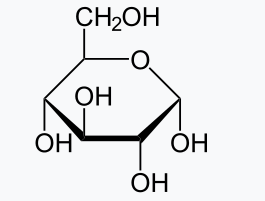
Which of the following statements describes how the body utilizes this molecule and others in its class of macromolecules?
A. Sugars are broken down to build proteins that become parts of the body’s cells, tissues, and structures.
B. Carbohydrates are formed from sugars, which are chemically bound together to form fats that store energy.
C. Various types of carbohydrates contribute to a supply of glucose, which is metabolized to provide quick energy.
D. Glucose is the product made from the breakdown of complex carbohydrates, and it is used to form membranes.
C. Various types of carbohydrates contribute to a supply of glucose, which is metabolized to provide quick energy.
QUESTION 1
List the 6 criteria for something to be considered science. Use the acronym CONPTT.
Consistent
Observable
Natural
Predictable
Testable
Tentative
The cytoplasm of animal cells has a concentration of potassium ions (K+) as much as 20 times higher than the concentration outside the cell. How do cells move potassium ions against a concentration gradient, from a LOWER concentration to a HIGHER one?
A. Facilitated diffusion
B. Osmosis
C. Active transport
D. Diffusion
C. ACTIVE TRANSPORT
Use the figures below to answer the question.
Figure 1: Enzymatic activity vs. optimal pH level
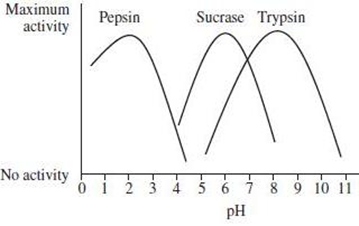
Figure 2: Enzymatic Description
ENZYME
DESCRIPTION
Trypsin
Excreted by the pancreas and aids digestion of proteins and other biological molecules.
Sucrase
Digestive enzyme secreted in the small intestine to break down sucrose to glucose or fructose which are more easily digestible.
Pepsin
Located in the stomach to assist the breakdown of proteins into smaller peptides during animal digestion.
Based on the information found in Fig. 1 and Fig. 2, which of the following statements regarding enzymatic activity in digestive enzymes is accurate?
A. A person with a diet rich in fruit would have digestive enzymatic activity highest in their stomach at a pH of 7.
B. At a pH of 2, animals ingesting a large amount of meat would most likely have an optimal enzymatic function.
C. A diet high in fats would be most optimally assisted by enzymes functioning at a pH of 11.
D. There is a high correlation that enzymes that function to aid digestion are optimally active in alkaline ranges.
B. At a pH of 2, animals ingesting a large amount of meat would most likely have an optimal enzymatic function.
The picture below shows a DNA strand during the process of replication.
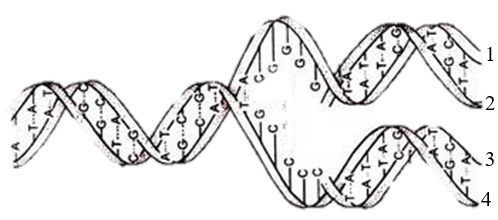
Which strands represent the original one found in the parent DNA molecule?
A. 1 & 2
B. 3 & 4
C. 2 & 3
D. 1 & 4
D. 1 & 4
In order to be hired at a new job, Richard had to participate in a drug test where a urinalysis was performed. A urinalysis is a test to analyze the contents of your urine. The chart below shows the findings.
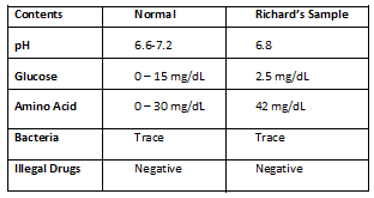
Which of the following structures are outside of the normal range, and are found in excess in Richard’s sample?
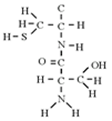
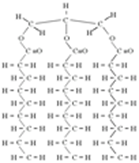
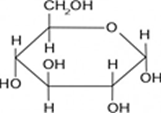
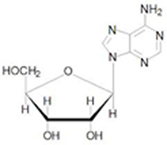

QUESTION 2
If you watched the Olympics this summer, you likely saw many Olympic athletes covered in perfectly circular red spots. These red spots are left by a therapeutic tool, known as cupping. Cupping is an ancient therapy, most prominently used in Middle Eastern and Asian countries. Cupping has recently started to become popular in the United States over the past few years.
The process of cupping involves heating glass suction cups and placing them on the treatment area. The suction cups are usually left on the skin for around 5 minutes before they are removed. As the suction cups cool down, a partial vacuum is formed with the skin. The number of cups that are used is dependent upon the size of the treatment area; the bigger the area, the more cups that are used.
Cupping is believed to relieve pain by stimulating the muscles while increasing blood flow. It has also been shown as a form of deep-tissue massage that helps with the relaxation of sore muscles. Unfortunately, there has not been much research conducted that shows the positive effects of cupping.
Cupping might be the new “fad” therapy for Olympic, professional, and collegiate athletes. Over the past 10 years, Kinesiotape, cryotherapy chambers and power bands have all become well-known and are used by professional
athletes. With the limited research on cupping, time will tell if this therapy will be around in 4 years for the next Summer Olympics.
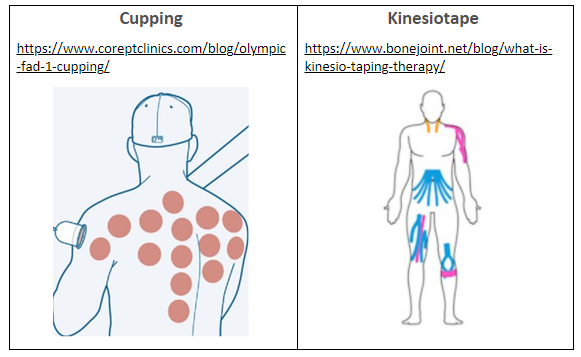
Based on this information, which of the following statements is true?
A. Cupping is a proven scientific method of relieving pain since it has been used for centuries.
B. Cupping and Kinesiotape would be accepted by the medical community once more scientific research is available.
C. If Olympic and professional athletes are using these methods to improve performance, they are safe and effective for anyone.
D. Establishing the scientific value of these therapies is difficult because there is no way to get consistent data about their use.
B. Cupping and Kinesiotape would be accepted by the medical community once more scientific research is available.
6. In an emergency trauma room, a doctor accidentally gives a patient a large transfusion of distilled water directly into one of his veins instead of blood. Predict what might happen if distilled water was given to the patient instead of blood.
A. have no unfavorable effect as long as the water was sterile
B. have serious, perhaps fatal effects because there would be too much fluid for the heart to pump.
C. have serious, perhaps fatal effects because the red blood cells would tend to shrivel
D. have serious, perhaps fatal effects because the red blood cells would tend to burst
D. have serious, perhaps fatal effects because the red blood cells would tend to burst